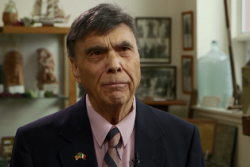| |
We The Italians Interview
|
|
Italian Magazine and Web Site Interview with
Professor Dinovo

|
Published on Tuesday, 15 September 2015 09:07
|
|

|
New York is no doubt the State with the
highest number of Italian Americans in the
country. Nevertheless, even if almost
everybody seems to be interested just in New
York City, in Upstate New York there is a huge
Italian American population.
In Albany, the Capital city of the Empire
State, about 150 miles north to Manhattan
there is plenty of them; and there is also a
museum and cultural center that celebrates our
heritage and culture. As often, this museum
exists thanks to a visionary pioneer who
founded it and still volunteer there:
Professor Philip DiNovo.
Philip, you are the founder and President of
the American Italian Heritage Association and
Museum in Albany, NY. Can you tell us
something about the history of this
institution?
Well, back in 1979 I called together other
college professors and we discussed that at
that time we heard people starting to realize
we had a wonderful cultural heritage. These
professors agreed with me that we should start
an organization to record and preserve our
Italian heritage. I met them in the Syracuse
University Law School and then, from there, we
continued to meet, and build and grow, and
then we founded the American Italian Museum.
This museum is different from the museums in
Italy, because its purpose is to honor the
Italian immigrants and made possible for other
Italians to have the kind of life that we have
in America thanks to their sacrifice. This
sacrifice sometimes was huge: I have a plaque
here that shows all the Italian Americans that
were lynched here in the US.
Another mission of the Museum is to inform
people of the contribution that the Italian
Americans gave to the US, so we have exhibits
about our history and a gift shop. On the
second floor, there is the Italian Cultural
Center where we have a small art gallery, a
classroom, a chapel. The building was
completed in 1922: it is a very unique
architectural, it resembles a mission that you
would find in the south west of the US, it is
very unique. Before it was a church, we made
it a 5,800 square feet museum and it took us
five years to restore it, and nine years to
get to the second floor, so we have really
achieved something outstanding: and we all
volunteer, no one gets paid.
Unfortunately, we Italian Americans are not
united, we do not work together. The other
Italian American museums existing in New York
City, Los Angeles, San Francisco, New Orleans,
Philadelphia ... we all would be much stronger
working together, because the question is "How
is our culture going to survive in the US?" I
am concerned because I have a treasure here it
took 35 years to collect, and we do not have
an endowment. You've got to have an endowment
like colleges or university so that you're
sure that the artifacts and the memory will be
preserved in the years coming, so the future
generations can learn about the immigrants
experience, what took place. This is a great
concern now because I am not getting any
younger and I want to make sure that this
museum survives.
There is an Irish Museum in Albany, it is
called the Irish Heritage Museum, and they get
support from the Irish government. I wish the
Italian government would do the same: the
Italian government spends a lot more time and
money in New York City, and it is
understandable, because it is the city with
the highest number of Italian Americans in the
country. However, they seem to have forgot the
Italian American population beyond New York
City.
Which activities do the association and the
museum organize during the year?
We are more than a museum. We do a special
exhibit every two months. We have cultural,
language and cooking classes, we have the book
club, we have an Italian card group, we have
book or documentary presentations, we play
bocce, we have many different events across
the year: we do many things to keep the
cultural heritage alive. We have a big Italian
Christmas market every year. There is people
here who used to go to Italy, who want to stay
in touch with their roots and with Italy, and
they come to us.
I am third generation, my grandparents were
born in Italy, my parents were born here and I
was born here. There are 155,000 Italian
Americans only in the five counties in the
metropolitan area of Albany, which is just a
portion of Upstate New York, where many other
Italian Americans live. This museum is great,
considering what we are up against, but it is
not at his full potential, because we have to
raise 145,000 $ a year, just to survive.
I think most of Italian Americans have lost
their heritage. They are only Italian in their
name, but they know very little about it. Our
food survives, yes, but our culture is much
more than our food. Sometimes a few third
generation Italians find their roots and they
are very interested in their heritage. Those
from the first generation, of course they were
very Italian, they had big adjustment. Their
children wanted to become American, so they
often tried to adjust their culture. Now, we
have Italians who say they are Italian but
they do not really know much about it. And you
can't keep a cultural heritage alive by just
words. What we have to do is to transform
words in action, but that is the big problem:
how do you do that with young people?
The web is one way, that is what We the
Italians is trying to do
We too, we are using the web, but I am
concerned about how do we transfer that into
action? Is it going to be just entertainment
with no education, nothing learnt? How do we
get them to want to go to Italy, to learn
Italian?
What's the story of the Italian emigration to
Upstate New York?
Well, a small curiosity is that the first
Italian who came to New York State did not
come to New York City in 1635 as they claim:
the first ones came ten years before to
Albany, they came with the Dutch.
Many of the Italians who came to Upstate New
York, first lived in New York City and then
they heard about opportunities Upstate NY. We
have a library and we have some books that
tells a few of these stories. Some of them
were farmers, and they grew different
products, like onions for example. There were
many different factories up here, and the
railroads and the canals drew Italian workers:
so many cities Upstate New York had a large
Italian population. For example, in Utica,
where my first museum was from 1995 to 1998,
the majority of the people at that time were
Italian Americans, and they came because of
the mills. So, different opportunities brought
Italians in different cities Upstate New York.
And then what happened is that those Italians
would call other ones from their village or
small town and tell them that there were
opportunities Upstate.
Which are the most important "Italian" places
in Upstate New York?
We do have Little Italies in a few cities up
here, included Albany. They are not what they
used to be because many of those Italians
moved to better areas when they had financial
success. Talking about Albany, there is a new
documentary called "The Neighborhood That
Disappeared" about our Little Italy, which was
destroyed taking away 9,000 people from their
home and 333 businesses, the very heart of
Little Italy. Schenectady and Troy also still
have Little Italies, but very small ones.
We do still have some Italian parishes, fewer
than we used to have. We also still have some
places that are named after Italians, like
parks and streets.
Are there many Italians born in Italy and
recently emigrated to Albany and its environs?
We have a few because we have high tech here,
we have a big new complex in Albany. Our
organization has quite a few members who were
born in Italy and came here after the war, and
they speak Italian. They go back to Italy very
often because, you know, having born makes the
difference.
Is Made in Italy successful in Upstate New
York?
Stores have many Italian products. Made in
Italy has a very positive image.
Unfortunately, some people do not know the
difference between fake Made in Italy and real
Made in Italy. For instance, when I look for
olive oil, I have to keep attention because
sometimes I find a bottle with an Italian
name, but made somewhere else. Unless you do
your homework, you could be misled.
Is there any big important Italian Festival in
Albany?
No, because we lost many of our Italian
parishes. There is a quite populated Saint
Anthony Italian feast in Schenectady, there is
something in Troy in August and in Albany in
September, we also do Saint Joseph's table on
Saint Joseph Day and we celebrate Saint Lucy
here, and then we do something for Columbus as
well. In Utica they do something big for Saint
Cosma and Damiano. However, there is not a
huge Italian festival.
|
|
|
|
|
|
|
|
|
|
|

